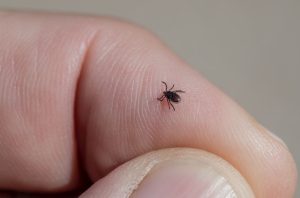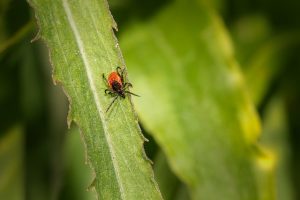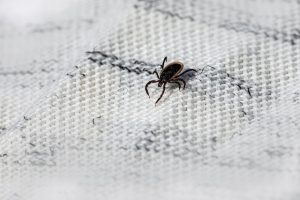Arkansas is a southern state known for its natural beauty and outdoor recreation opportunities.
However, with the great outdoors comes the risk of encountering ticks, which can carry a variety of diseases.
So, are ticks bad in Arkansas? Unfortunately, the answer is yes. Arkansas is home to a variety of tick species, some of which are known to transmit diseases to humans and animals.
Ticks are most commonly found in wooded areas, tall grasses, and brushy habitats, making them a common sight in Arkansas.
Some of the most common tick species found in Arkansas include the Lone Star tick, American dog tick, and black-legged tick.
These ticks can transmit a variety of diseases, including Lyme disease, Rocky Mountain spotted fever, and ehrlichiosis.
It is important for individuals spending time outdoors in Arkansas to take precautions to prevent tick bites and to know the signs and symptoms of tick-borne diseases.
Key Takeaways
- Arkansas is home to a variety of tick species that can transmit diseases to humans and animals.
- Ticks are most commonly found in wooded areas, tall grasses, and brushy habitats.
- It is important for individuals spending time outdoors in Arkansas to take precautions to prevent tick bites and to know the signs and symptoms of tick-borne diseases.
Understanding Ticks in Arkansas
Arkansas is home to several tick species, including the Lone Star tick, American dog tick, Brown dog tick, and Blacklegged tick (also known as Ixodes scapularis or deer tick).
These ticks can be found in various habitats, including grassy fields, wooded areas, and around homes and other structures.
The Lone Star tick, also known as Amblyomma americanum, is the most common tick species in Arkansas. It is easily identifiable by the white star-shaped spot on its back.
This tick is known to transmit diseases such as Ehrlichiosis, Tularemia, and Rocky Mountain spotted fever.
The American dog tick, also known as Dermacentor variabilis, is another common tick species found in Arkansas.
This tick is known to transmit diseases such as Rocky Mountain spotted fever and Tularemia.
The Brown dog tick, also known as Rhipicephalus sanguineus, is a tick species that is commonly found in homes and other structures.

This tick is known to transmit diseases such as Ehrlichiosis and Babesiosis.
The Blacklegged tick, also known as Ixodes scapularis or deer tick, is a tick species that is commonly found in wooded areas.
This tick is known to transmit diseases such as Lyme disease, Anaplasmosis, and Babesiosis.
It is important to take precautions to avoid tick bites when spending time outdoors in Arkansas.
These precautions include wearing long-sleeved shirts and pants, using insect repellent containing DEET, and checking for ticks on yourself and your pets after spending time outdoors.
In conclusion, ticks are a common presence in Arkansas, with several tick species found in various habitats.
Taking precautions to avoid tick bites is important to prevent the transmission of tick-borne diseases.
Tick Habitats and Season
Ticks are commonly found in wooded areas, tall grasses, and leaf litter. These habitats provide ticks with the necessary shelter and humidity to survive.
Ticks are more prevalent in areas with high humidity and moisture, such as wooded areas and leaf litter. They are also found in tall grasses, especially during the tick season.
Tick season in Arkansas typically starts in late spring and lasts through the summer months. During this time, the tick population is at its highest.
Ticks are most active during warm and humid weather, and tend to be less active during periods of drought. The peak of tick activity in Arkansas usually occurs in June and July.
Tick populations can vary greatly depending on the location and the weather conditions. Areas with high rainfall and humidity tend to have higher tick populations, while areas with less rainfall and drier climates tend to have lower tick populations.
Ticks are also more prevalent in areas with a high density of wildlife, such as deer and rodents, which serve as hosts for the ticks.
Tick-infested areas should be avoided, especially during the tick season. When spending time outdoors, it is recommended to wear long-sleeved shirts and pants, and to use insect repellent.
It is also important to check for ticks after spending time outdoors, and to promptly remove any ticks that are found.
In summary, ticks are commonly found in wooded areas, tall grasses, and leaf litter. Tick season in Arkansas typically starts in late spring and lasts through the summer months, with the peak of tick activity occurring in June and July.
Tick populations can vary greatly depending on the location and weather conditions, and tick-infested areas should be avoided.
Common Tick-Borne Diseases in Arkansas
Arkansas is home to a variety of ticks that can transmit several diseases to humans. These diseases can cause a range of symptoms, from mild to severe, and can even be fatal if left untreated.
In this section, we will discuss some of the most common tick-borne diseases that are prevalent in Arkansas.
Rocky Mountain Spotted Fever (RMSF)
RMSF is a bacterial infection that is transmitted by the American dog tick, the Rocky Mountain wood tick, and the brown dog tick.
Symptoms of RMSF include fever, headache, muscle aches, and a rash. If left untreated, RMSF can cause serious complications, such as damage to internal organs.
Ehrlichiosis
Ehrlichiosis is a bacterial infection that is transmitted by the Lone Star tick and the black-legged tick.

Symptoms of ehrlichiosis include fever, headache, fatigue, and muscle aches. In severe cases, ehrlichiosis can cause respiratory failure and kidney failure.
Lyme Disease
Lyme disease is a bacterial infection that is transmitted by the black-legged tick. Symptoms of Lyme disease include fever, headache, fatigue, and a characteristic bull’s eye rash. If left untreated, Lyme disease can cause joint pain, heart palpitations, and neurological problems.
Tularemia
Tularemia, also known as rabbit fever, is a bacterial infection that is transmitted by the Lone Star tick and the American dog tick. Symptoms of tularemia include fever, chills, headache, and muscle aches. In severe cases, tularemia can cause pneumonia and can be fatal if left untreated.
Anaplasmosis
Anaplasmosis is a bacterial infection that is transmitted by the black-legged tick and the western black-legged tick. Symptoms of anaplasmosis include fever, headache, muscle aches, and fatigue. In severe cases, anaplasmosis can cause organ failure.
Babesiosis
Babesiosis is a parasitic infection that is transmitted by the black-legged tick. Symptoms of babesiosis include fever, chills, fatigue, and muscle aches. In severe cases, babesiosis can cause hemolytic anemia and kidney failure.
Southern Tick-Associated Rash Illness (STARI)
STARI is a bacterial infection that is transmitted by the Lone Star tick. Symptoms of STARI include fever, headache, fatigue, and a rash. STARI is often mistaken for Lyme disease because of the similarity of the symptoms.
In conclusion, tick-borne diseases are a serious health concern in Arkansas. It is important to take precautions when spending time outdoors, such as wearing protective clothing and using insect repellent. If you experience any symptoms of a tick-borne illness, seek medical attention immediately.
Symptoms of Tick-Borne Diseases
Tick-borne diseases are caused by various bacteria, viruses, and parasites transmitted by ticks. Symptoms of tick-borne diseases can vary depending on the type of disease and the stage of infection. Common symptoms of tick-borne diseases include fever, rash, aches, headache, nausea, muscle pain, chills, malaise, vomiting, and pains. In this section, we will discuss the most common symptoms of tick-borne diseases.
Early Symptoms
In the early stages of tick-borne diseases, symptoms are often mild and non-specific. Symptoms may include fever, headache, muscle aches, and fatigue. Some people may also experience a rash, which may be circular and expand over time. This rash is often referred to as a “bull’s eye” rash and is a characteristic symptom of Lyme disease.
Later Symptoms
If left untreated, tick-borne diseases can progress and cause more severe symptoms. In the later stages of tick-borne diseases, symptoms may include joint pain, muscle weakness, numbness, and tingling. Some people may also experience neurological symptoms such as confusion, memory loss, and difficulty concentrating.
Other Symptoms
In addition to the symptoms mentioned above, tick-borne diseases can also cause other symptoms such as swollen lymph nodes, abdominal pain, and diarrhea. Some people may also experience respiratory symptoms such as coughing and shortness of breath.
It is important to note that not all tick bites result in tick-borne diseases. However, if you experience any of the symptoms mentioned above after a tick bite, it is important to seek medical attention. Early diagnosis and treatment of tick-borne diseases can help prevent more serious complications.
Preventing and Treating Tick Bites
Ticks are a common problem in Arkansas, and it is important to take precautions to prevent tick bites. The following measures can help reduce the risk of tick bites:
- Wear light-colored clothing that covers the arms and legs. Ticks are easier to spot on light-colored clothing.
- Apply an insect repellent containing DEET or permethrin to exposed skin and clothing. Repellents with at least 20% DEET are effective for several hours, while permethrin can be applied to clothing for long-lasting protection.
- Check for ticks frequently, especially after spending time outdoors in wooded or grassy areas. Use clean, fine-tipped tweezers to remove any ticks that are found.
- Treat clothing and gear with permethrin, which can kill ticks on contact.
If a tick is found attached to the skin, it should be removed immediately. The following steps can help safely remove a tick:
- Use fine-tipped tweezers to grasp the tick as close to the skin’s surface as possible.
- Pull upward with steady, even pressure. Do not twist or jerk the tick, as this can cause the mouthparts to break off and remain in the skin.
- After removing the tick, clean the bite area with rubbing alcohol or soap and water.
- If you develop a rash or fever within a few weeks of a tick bite, seek medical attention.
It is important to note that home remedies such as using petroleum jelly, nail polish, or heat to remove a tick are not effective and can actually increase the risk of infection.
In conclusion, taking preventive measures and promptly removing ticks can help reduce the risk of tick-borne illnesses in Arkansas.
Ticks and Pets
Ticks are a common problem in Arkansas, and pets are particularly vulnerable to tick bites. Ticks can cause a range of health problems in pets, including Lyme disease, Rocky Mountain spotted fever, and ehrlichiosis. These diseases can be serious and even life-threatening if left untreated.
Pets that spend time outdoors, especially in wooded or grassy areas, are at the greatest risk of tick bites. Dogs are particularly susceptible to tick bites, but cats can also be affected. It is important for pet owners to be vigilant and take steps to protect their pets from ticks.
Some ways to protect pets from ticks include:
- Using tick preventatives recommended by a veterinarian
- Checking pets for ticks after spending time outdoors
- Keeping pets away from areas with high tick populations
- Keeping pets well-groomed and free of matted fur
- Vacuuming carpets and furniture regularly to remove any ticks that may have hitched a ride inside
If a pet is bitten by a tick, it is important to remove the tick as soon as possible. This can be done with tweezers or a tick removal tool, and the area should be cleaned with soap and water. If a pet shows any signs of illness after a tick bite, such as fever, lethargy, or loss of appetite, they should be taken to a veterinarian for evaluation.
It is also important to note that ticks can be carriers of other pests, such as fleas and rodents. Pet owners should take steps to control these pests as well, as they can also pose health risks to pets.
Overall, ticks can be a serious health concern for pets in Arkansas. However, with proper prevention and treatment, pet owners can help protect their furry friends from tick-borne diseases.
Public Health and Tick-Borne Diseases
Ticks are not only a nuisance but also a significant public health concern. In Arkansas, ticks are known to transmit several tick-borne diseases, including Lyme disease, Rocky Mountain spotted fever, and tularemia. The Arkansas Department of Health (ADH) recognizes the importance of tick-borne disease prevention and provides resources to help the public better understand the risks and how to protect themselves.
According to the ADH, the most common tick-borne diseases in Arkansas are Rocky Mountain spotted fever and tularemia. Rocky Mountain spotted fever is caused by the bacterium Rickettsia rickettsii, which is transmitted by the American dog tick, the Rocky Mountain wood tick, and the brown dog tick. Tularemia, also known as rabbit fever, is caused by the bacterium Francisella tularensis and is transmitted by ticks, deer flies, and other biting insects.
Symptoms of tick-borne diseases can vary depending on the disease, but they often include fever, headache, muscle aches, and fatigue. In severe cases, tick-borne diseases can cause organ damage and even death. Therefore, it is essential to take preventive measures to avoid tick bites.
The ADH recommends the following measures to prevent tick bites:
- Use insect repellent with DEET
- Wear long-sleeved shirts and pants
- Tuck pants into socks or boots
- Check for ticks frequently and remove them promptly
- Shower soon after being outdoors
In addition to these preventive measures, the ADH encourages people to seek medical attention if they develop symptoms after being bitten by a tick. Early diagnosis and treatment are crucial for a full recovery.
Overall, tick-borne diseases are a significant public health concern in Arkansas. By taking preventive measures and seeking medical attention when necessary, individuals can protect themselves from these diseases.
Diagnosis and Treatment of Tick-Borne Diseases
Tick-borne diseases are a significant health concern in Arkansas. Proper diagnosis and treatment are crucial to prevent serious complications. The diagnosis of tick-borne diseases is based on clinical symptoms and laboratory tests. The most common tick-borne diseases in Arkansas are Lyme disease, Rocky Mountain spotted fever, and Ehrlichiosis.
Diagnosis
The diagnosis of tick-borne diseases is challenging due to the wide range of symptoms and the possibility of co-infection. The initial symptoms of tick-borne diseases are similar to other common illnesses, making it difficult to diagnose. Therefore, it is essential to consider the possibility of tick-borne diseases in patients who have been bitten by ticks or have been in areas where ticks are prevalent.

Laboratory testing is essential for the diagnosis of tick-borne diseases. The most commonly used tests are serological tests, which detect antibodies against the pathogen. Polymerase chain reaction (PCR) tests are also used to detect the DNA of the pathogen. However, the sensitivity and specificity of these tests vary, and false-negative results are possible.
Treatment
The treatment of tick-borne diseases depends on the specific disease and the severity of the symptoms. Antibiotics are the primary treatment for most tick-borne diseases. The choice of antibiotic depends on the specific disease and the patient’s age and medical history. Doxycycline is the first-line treatment for most tick-borne diseases, including Lyme disease, Rocky Mountain spotted fever, and Ehrlichiosis. Other antibiotics, such as amoxicillin, cefuroxime, and azithromycin, may be used in certain cases.
In conclusion, tick-borne diseases are a significant health concern in Arkansas. Proper diagnosis and treatment are essential to prevent serious complications. The diagnosis of tick-borne diseases is based on clinical symptoms and laboratory tests. Antibiotics are the primary treatment for most tick-borne diseases. If you suspect that you have been exposed to ticks or have symptoms of a tick-borne disease, seek medical attention immediately.
Special Cases of Tick-Borne Diseases
Tick-borne diseases are a significant public health concern in Arkansas. While most tick bites do not result in illness, some ticks can transmit serious diseases to humans. The most commonly reported tick-borne diseases in Arkansas are Rocky Mountain spotted fever, ehrlichiosis, and tularemia. However, there are some special cases of tick-borne diseases that are worth noting.
Alpha-gal Allergy
Alpha-gal allergy is a relatively new and rare tick-borne disease that has been reported in Arkansas. This allergy is caused by the bite of the lone star tick, which is commonly found in the state. The allergy is characterized by an immune reaction to alpha-gal, a sugar molecule found in red meat. Symptoms of alpha-gal allergy include hives, itching, swelling, and difficulty breathing. The allergy can develop hours after eating red meat and can last for several hours.
Tularemia
Tularemia is a bacterial disease that can be transmitted to humans through the bite of infected ticks, including the lone star tick. Arkansas and Missouri are considered the primary national focus of tularemia in humans due to the historical prominence of the disease in these states. Symptoms of tularemia can include fever, headache, muscle aches, and swollen lymph nodes. In rare cases, tularemia can be fatal.
Lyme Disease
While Lyme disease is not commonly reported in Arkansas, it is still possible to contract the disease in the state. Lyme disease is caused by the bite of infected blacklegged ticks, which are not as prevalent in Arkansas as they are in other parts of the country. Symptoms of Lyme disease can include fever, headache, fatigue, and a characteristic bull’s-eye rash. If left untreated, Lyme disease can lead to more severe symptoms, including joint pain and neurological problems.
In conclusion, while most tick bites do not result in illness, it is important to be aware of the special cases of tick-borne diseases that can occur in Arkansas. The best way to prevent tick-borne diseases is to take precautions when spending time outdoors, such as wearing protective clothing and using insect repellent. If you do get bitten by a tick, it is important to remove it promptly and monitor for any symptoms of illness.
Ticks and Their Relation to Deer
Ticks are commonly found in Arkansas and are known to be a nuisance to both humans and animals. One of the most common hosts for ticks is the white-tailed deer, which is prevalent in the region.
Ticks are ectoparasites, which means they live on the outside of their host’s body and feed on their blood. The life cycle of ticks typically involves four stages: egg, larva, nymph, and adult. During the larval and nymphal stages, ticks often feed on small mammals, such as rodents, before moving on to larger hosts, such as deer, during the adult stage.
Deer are particularly susceptible to tick infestations due to their large size and the fact that they often inhabit areas with dense vegetation, which provides an ideal habitat for ticks. As a result, deer are often referred to as “tick magnets.”
Ticks can have a negative impact on deer populations in several ways. Firstly, tick infestations can cause deer to experience stress, which can lead to a weakened immune system and a decrease in overall health. This can make deer more susceptible to other diseases and infections.
Secondly, ticks can also transmit diseases to deer, such as Lyme disease and anaplasmosis. These diseases can cause a range of symptoms, including fever, lethargy, and joint pain. In severe cases, they can even lead to death.
Finally, tick infestations can also have an economic impact on the hunting industry. Deer that are infested with ticks may have reduced body weight and antler size, which can make them less desirable to hunters.
Overall, ticks and their relation to deer can have significant impacts on both the health of the deer population and the hunting industry in Arkansas. It is important for individuals to take measures to protect themselves and their pets from tick bites, and for hunters to be aware of the potential impacts of tick infestations on the deer population.
Ticks and Their Geographic Spread
Ticks are a common problem in Arkansas, as they are in many other parts of the United States. Ticks are small arachnids that feed on the blood of mammals, birds, and reptiles. They can carry a variety of diseases, including Lyme disease, Rocky Mountain spotted fever, and tularemia.
The geographic spread of ticks in the United States varies depending on the species of tick. For example, the blacklegged tick (also known as the deer tick) is most commonly found in the northeastern and upper midwestern regions of the country. Meanwhile, the lone star tick is more common in the southeastern United States.
In Arkansas, the most common tick species are the Lone Star tick and the American dog tick. Both of these species are known to carry diseases that can be harmful to humans. The geographic distribution of these ticks in Arkansas is widespread, with both species found throughout the state.
Ticks are particularly prevalent in wooded areas, as well as in grassy fields and meadows. They are also commonly found on domestic animals, such as dogs and cats, which can bring them into the home.
To protect against ticks, it is recommended that individuals wear long sleeves and pants when spending time outdoors in wooded or grassy areas. It is also important to use insect repellent that contains DEET. Additionally, individuals should check themselves and their pets for ticks after spending time outdoors, as prompt removal can help reduce the risk of disease transmission.
Ticks and Their Impact on Children
Ticks are small, blood-sucking arachnids that can cause a variety of illnesses, including Lyme disease, Rocky Mountain spotted fever, and tularemia. Children are particularly vulnerable to tick bites because they tend to spend more time outside playing, hiking, and camping. In Arkansas, where ticks are prevalent, it is important for parents to take steps to protect their children from tick bites.
Ticks are most commonly found in wooded areas, tall grasses, and brushy areas. They can attach themselves to any part of the body, but are most commonly found around the ankles, behind the knees, and in the groin area. Children who spend a lot of time outside, especially in these areas, are at a higher risk of being bitten by ticks.
The impact of tick bites on children can be severe. In addition to the illnesses mentioned above, tick bites can cause allergic reactions, infection, and even paralysis. It is important for parents to check their children for ticks after spending time outside and to remove any ticks they find as soon as possible.
To protect children from tick bites, parents should encourage them to wear long pants and sleeves when outside, use insect repellent that contains DEET, and avoid walking through tall grasses and wooded areas. Parents should also check their children for ticks daily, paying close attention to the ankles, behind the knees, and in the groin area.
In conclusion, ticks can have a serious impact on children in Arkansas. Parents should take steps to protect their children from tick bites by encouraging them to wear protective clothing, using insect repellent, and checking them for ticks daily.
